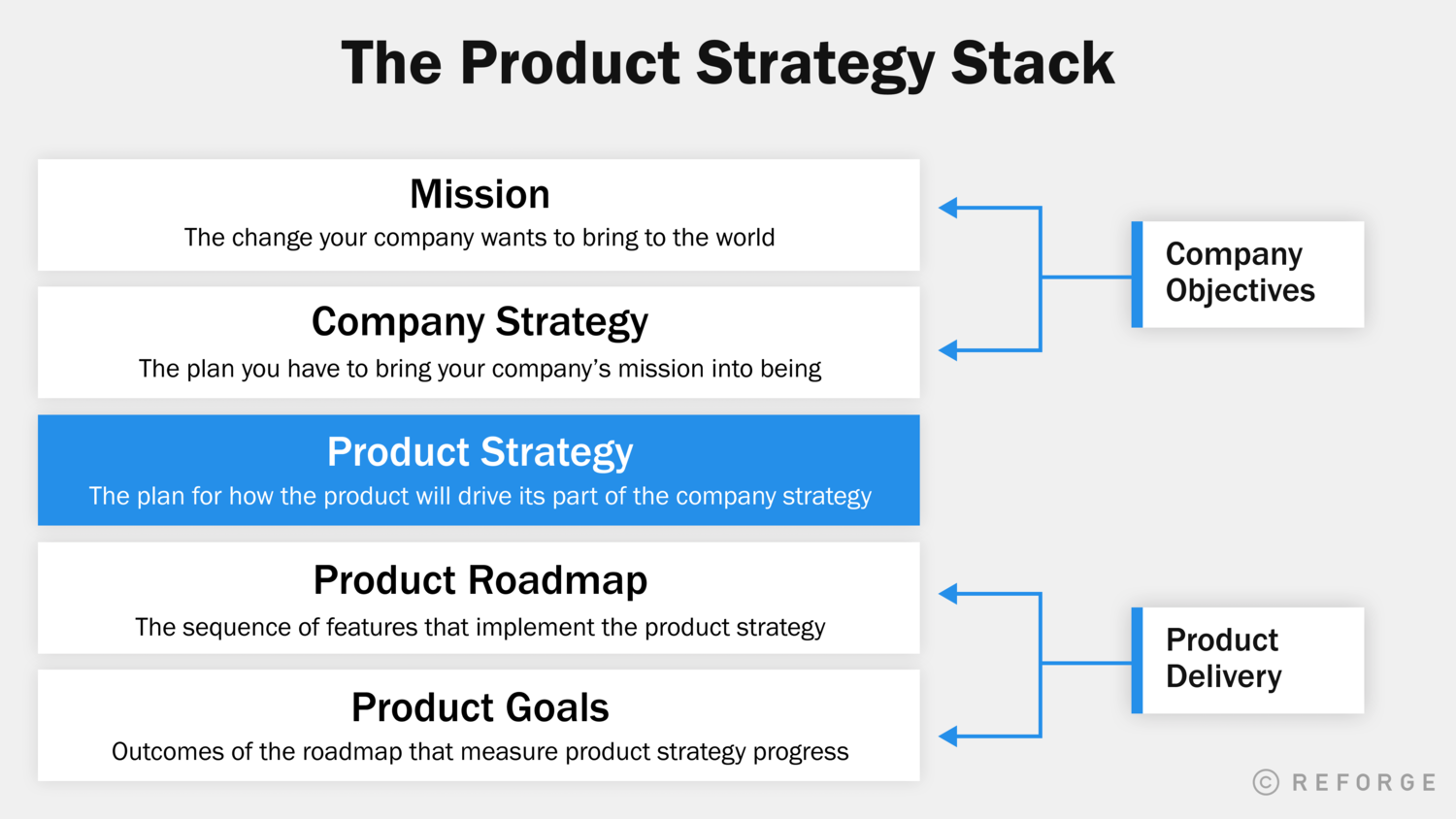I’m fascinated by strategies. I’ve been following the recent challenges faced by Starbucks. The previous CEO’s focus on operational efficiency and digital initiatives, came at the expense of the brand’s distinctive identity. Customers began to miss the in-store experience that made Starbucks special. Now, the new CEO wants to reconnect the company with its core strengths through a new strategy.
My own views on product strategy have evolved over time. I once equated Objectives and Key Results (OKRs) with strategy. Now, I recognise them as a goal-setting framework that supports the execution of the vision. OKRs are invaluable for translating strategic intent into actionable quarterly objectives. They should not replace the overarching product strategy.
So, what exactly is a product strategy? It’s a high-level plan that outlines how a business aims to achieve its product vision. Ravi Mehta discusses how the vision and strategy connect using ‘The Product Strategy Stack’.
 ‘Product Strategy Stack’ an image by Ravi Mehta: https://www.ravi-mehta.com/product-strategy-stack/
‘Product Strategy Stack’ an image by Ravi Mehta: https://www.ravi-mehta.com/product-strategy-stack/
A well-crafted strategy provides a clear framework for making informed decisions about product development, people allocation, and market opportunities. It aligns teams and stakeholders towards common goals.
Five key areas that make a strategy
Crafting a robust strategy can be daunting. To simplify the process, Product School offers an effective template.
- Product Vision: define where you want your product to be in five years.
- Product Insights: gather quantitative and qualitative data to understand your users, competitors, and market trends.
- Challenges: identify potential risks or issues that could impact product development.
-
Approaches: how will you disrupt the market?
- Market Penetration and Expansion: increase market share in existing or new spaces.
- Product Development: introduce new offerings to meet emerging needs.
- Diversification: create new products to reduce reliance on a single market.
- Cost Competition: attract customers by providing lower prices.
- Quality Differentiation: stand out by delivering superior quality and performance.
- Accountability: define how you will measure success and outcomes.
 ‘A chess piece knocking off the black king piece’ an image by Pixabay: https://www.pexels.com/photo/man-holding-chess-piece-277124/
‘A chess piece knocking off the black king piece’ an image by Pixabay: https://www.pexels.com/photo/man-holding-chess-piece-277124/
Roger Martin’s strategy choice cascade
This alternative approach provides a structured way to clarify your strategic direction:
- What is our winning aspiration?
Define your ultimate goal. This should guide all decisions and actions, ensuring a focused approach.
- Where will we play?
Identify the specific markets, segments, or niches where you intend to compete. Maintaining focus is essential. Spreading yourself too thin can undermine your effectiveness.
- How will we win?
Establish your competitive advantage. Provide customers with superior value or operate at a lower cost.
- What capabilities must be in place to win?
Identify and develop the essential capabilities required to execute your strategy. These should be unique strengths that differentiate you from the competition.
- What management systems are needed to support these capabilities?
Put in place systems and processes that will sustain your capabilities over time. This ensures your strategy remains viable and adaptable to evolving market conditions.
Good strategy, bad strategy
In developing your strategy, reflect on your achievements. Be intentional about what you choose not to prioritise. Keep your strategy simple and accessible for everyone, avoiding complex jargon. A bad strategy is dull, and uninspiring.
There are many ways to create a strategy:
- I appreciate how simple the Ministry of Justice’s strategy is..
- I like the regular updates and accountability in the Royal Borough of Greenwich’s strategy..
- I admire the passion shown by Slack’s Stewart Butterfield. It’s inspiring, and it gets people excited about building towards his vision.
- Aatir’s product strategy is comprehensive and thorough.
Competitor analysis
The 5 Forces Framework helps businesses analyse their competitive environment. Here’s a practical breakdown of each force. I’ll use Spotify as an example.
-
Threat of New Entrants: how easy it is for new competitors to enter the market. High barriers, like capital requirements and brand loyalty, can protect existing companies.
-
Bargaining Power of Suppliers: the influence suppliers have over prices and quality. Fewer suppliers or unique products increase their power.
-
Bargaining Power of Buyers: how much power customers have over prices and quality. High switching ease increases their bargaining power.
-
Threat of Substitute Products or Services: the likelihood of customers opting for alternatives that meet the same needs.
-
Industry Rivalry: evaluates the level of competition among existing players. High rivalry can lead to price wars and decreased profitability.
 5 Forces Framework applied to Spotify.
5 Forces Framework applied to Spotify.
Other ways to think about strategy
The Product Strategy Canvas, created by Melissa Perri, simplifies strategy development by capturing the vision and using data to analyse the current state. Additionally, the North Star Metric (NSM) aligns teams around key metrics like acquisition, retention, and monetisation, focusing on the actions that drive these scores. The Narrative, Commitments, Tasks (NCT) approach, proposed by Ravi Mehta, offers a motivating alternative to OKRs. This method includes a Narrative that outlines team objectives, Commitments that define verifiable goals, and flexible Tasks that support these commitments.
 ‘Product Strategy Canvas’ an image by Melissa Perri: https://medium.com/@melissaperri/what-is-good-product-strategy-8d5587cb7429
‘Product Strategy Canvas’ an image by Melissa Perri: https://medium.com/@melissaperri/what-is-good-product-strategy-8d5587cb7429
Conclusion
Share your strategy in team meetings, use visual aids, and incorporate it into daily conversations. Stay adaptable, seek feedback from stakeholders, and be ready to pivot in response to emerging trends and customer needs.
In my next blog post in this series, I share a real world example of a strategy I wrote as a Head of Product.
I’ll come back to this blog post in a few years. It will be interesting to see if my thoughts have changed!


